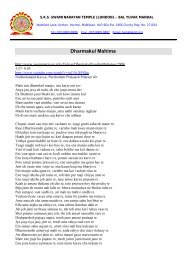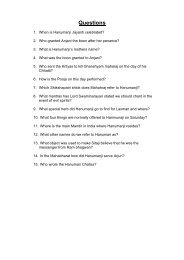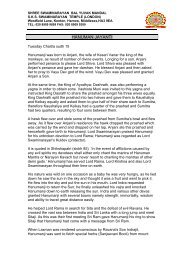Shikshapatri Bhashya Shlok 41 - Shree Kutch Satsang ...
Shikshapatri Bhashya Shlok 41 - Shree Kutch Satsang ...
Shikshapatri Bhashya Shlok 41 - Shree Kutch Satsang ...
Create successful ePaper yourself
Turn your PDF publications into a flip-book with our unique Google optimized e-Paper software.
S.K.S. SWAMINARAYAN TEMPLE (LONDON) – BAL YUVAK MANDAL<br />
Westfield Lane, Kenton, Harrow, Middlesex, HA3 9EA Est. 1966 Charity Reg. No. 271034<br />
Tel: 020 8909 9899<br />
Fax: 020 8909 9897 Email: bym@sksst.org<br />
•<br />
<strong>Shikshapatri</strong> <strong>Bhashya</strong> <strong>41</strong><br />
║ Those of my Brahmin, Kshatriya and Vaishya disciples who have been initiated into the<br />
devotion of <strong>Shree</strong> Krishna by their Guru shall always wear around their neck a double kanthi<br />
prepared from tulsi wood and shall mark their forehead, chest and arms and with a tilak ║<br />
Initiation into a Samradaya is much more than one realises. After initiation one needs to follow the code<br />
of conduct stipulated by the Acharya. Only then does one have a right to worship God. (Shatanand<br />
Muni) How do we choose the right Guru?<br />
A worthy Guru:<br />
• Has control over his senses;<br />
• Is pure and pious;<br />
• Of high intellect or wisdom;<br />
• Full bodied;<br />
• Follows the Dharma; and<br />
• Whose mind, speech and body are employed to protect and comfort those in need.<br />
It is extremely important that one is initiated into a worthy Sampradaya, headed by a worthy Guru/<br />
Acharya.<br />
The Krishna Mantra<br />
In our Sampradaya we refer to this as the ‘Guru Mantra’ or ‘Krishna Ashtakshar Mantra’. This is<br />
samanya diksha and the mantra should be recited everyday in our pooja. We also have bhagvati<br />
diksha for those who become saints and sankhyogis.<br />
Twice borns (Dwija) have to attain diksha. These are Brahmins Kshatriyas and Vaishayas. Why are<br />
they twice born? Once when they are born, and again when they have their yagnopavit (what is this?)<br />
ceremony. Those without diksha face death and rebirth as an animal. They are considered a burden on<br />
Earth (Padma Puran, Uttar Khanda).<br />
Kanthi (Tulsi mala)<br />
This signifies Jugal Upaasna (bhakta-bhagwan relationship, as is that between Radha and Krishna,<br />
swami sevak or Jeev and Shiv). Tusli is used because of its sacredness within Hinduism. It is another<br />
sign of initiation into the Sampradaya.<br />
It is said that Yamdoots do not come near those who wear kanthis. A dog with a dog collor is a stray,<br />
and is eventually rounded up by dog catchers. In the same way, a person without a kanthi is a stray<br />
and is eventually caught by the Yamddots. Anyone who doesn’t wear a kanthi is consumed by fire and<br />
falls to hell. If you eat or drink without a kanthi, then that food and water is considered to be meat and<br />
liquor. When we where a kanthi we should recite:
S.K.S. SWAMINARAYAN TEMPLE (LONDON) – BAL YUVAK MANDAL<br />
Westfield Lane, Kenton, Harrow, Middlesex, HA3 9EA Est. 1966 Charity Reg. No. 271034<br />
Tel: 020 8909 9899<br />
Fax: 020 8909 9897 Email: bym@sksst.org<br />
II Tulsikashtasambhutemale Vishnujanapriya<br />
Bibharmi Tvamahan Karashte Kuru Mam Krushnavallabham II<br />
‘O rosary made of Tulsi, which is adored by all Vaishnavas! I place thee around my neck. Grant that I<br />
be fond of Krishna as I wear thee.’<br />
Note: Just because we wear a kanthi does not make us <strong>Satsang</strong>is. We need to follow the Panch<br />
Vratman in order to prove our worthiness. The kanthi IS NOT a fashion accessory which can be worn<br />
with 1 strand or 3. Can we have a kanthi which has been made from gold? Discuss. – could argue that<br />
the use of gold is ordained, but at the same time it may take away the humbleness and simplicity of<br />
kanthi.<br />
Tilak Chandlo<br />
Those who do not do a Tilak do not have the right to the fruits of their actions. Yagnas, daan, jap,<br />
offereings, svadhyay (Vedic study) and shraadh (offerings to dead ancestors) hold no fruits if not done<br />
with a Tilak. If you have a tilak and perform shraadh then you attain the fruits of 10 million such<br />
ceremonies over millions of years gone by.<br />
Vaishnavs regardless of caste should wear the tilak. However, a devotee of Shiva should not abandon<br />
the tripundra. The tilak is known as the footprint of God. By wearing the mark we are advertising our<br />
faith and devotion to the Lord.<br />
Men should wear the ‘U’ Shaped tilak daily and should be done using gopichandan. They should say<br />
the following mantras whilst applying it in the order shown below:<br />
• Forehead (to bring development of the mind and intellect) – Om Vasudevaiya Namah;<br />
• Centre of chest (to bring health and vitality) – Om Shankarshanaiya Namah;<br />
• Right Upper Arm – Om Pradyumnaiya Namah; and<br />
• Left Upper Arm – Om Annirudhaiya Namah (marks on the arms prevent unscrupulous acts and<br />
bring pure actions).<br />
A kum kum chandlo should be worn in the middle of the ‘U’ (Urdvapundra) on the forehead. Whilst<br />
applying the chandlo one should recite ‘Om Maha Laxmine Namah’. Please note that female devotees<br />
should only apply the chandlo and not the Urdvapundra.<br />
As above, the tilak chandlo is not a fashion accessory, and therefore different shapes and stick on<br />
bindis are not acceptable. What can we say to those who are ashamed to wear tilak chandlos?<br />
• A forehead without a chandlo is somewhat dim.<br />
• Those with a tilak look livelier and it brings beauty to the face.<br />
• If other faiths are not scared or ashamed to show their marks of faith then why should we be?






